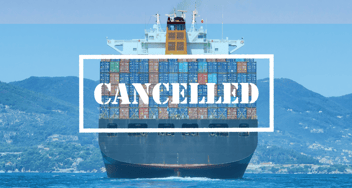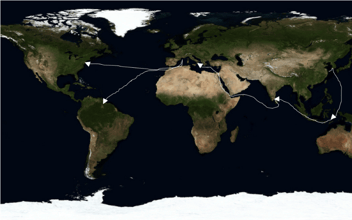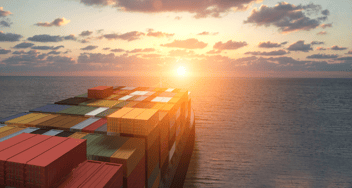How To Get Real Maritime Supply Chain Visibility?
Visibility and Tracking-1.jpg)
With the complexities of the supply chain and the competition on the market, making your supply chain as efficient as possible is essential to the success of an organization. The only way to do that is by having proper visibility and control over your maritime supply chain.
In this article, discover everything you need to know about visibility and control in ocean transportation. Learn about solutions on the market that will provide you with what you need for an efficient modern supply chain. And ultimately, find out the limits of visibility and what you truly need to be able to properly control your supply chain.
Why You Need More Visibility Over Your Ocean Transportation
Before discussing how to harness technology to get better visibility, let us see why we need it in the first place.
As an exporter, you need to have visibility over your shipments because you need to be able to react swiftly to any exceptions that arise. The sooner you know about an exception at sea, the sooner you can organize another plan to get your shipment to its destination as quickly as possible.
Visibility is also important for importers as well. If a shipment’s arrival is delayed, the importer needs to know to adjust the coordination for the container pickup. If not, they risk having troubles re-coordinating the pickup and can even encounter tucking fees.
In any case, exceptions affect the entire supply chain so both importers and exporters need to know of changes as soon as possible to ensure timely delivery.
Limits Of Supply Chain Visibility Software On The Market
Supply chain visibility is not a new challenge and there are various software on the market that try to address it. However, the visibility offered is limited and they only show the ETA of containers at sea. More importantly, visibility alone is not going to save your supply chain.
Knowing about a delay is not going to help you fix the problem. What you really need is control- control to be able to react to exceptions rather than just watching them helplessly.
Limits Of At-Sea Visibility
With most visibility solutions, data about container position is usually sourced from the carriers. Most software depends on a single source of data which means it isn’t always 100% accurate. If the carrier doesn’t update their location, shippers can’t view the container’s position or status.
Limits Of Not Having Visibility At Booking
Software available in the market offers negligible data analytics before booking. For example, it may not indicate how many past shipments have been delayed. If you cannot see beforehand that a shipment is likely to be delayed, the solution is not providing you with as much visibility as you need to properly control your supply chain.
Limits Of Not Having Visibility Over Other Parts Of Your Operations
Similarly, for many visibility solutions, information about operations and documents is also limited. You cannot find out what has been completed and what is left to be done or whether all documentation is in order or not. Communication and operations like these are often scattered between emails and calls. The absence of this data keeps you from taking the necessary steps to maintain a seamless supply chain until a problem is reported.
How To Get More Global Visibility Over Your Maritime Operations
For smooth supply chains, you need a solution that improves visibility and gives you control over all the maritime operation steps. You need to be able to search, book and plan shipments in a single place.
Get A Solution That Gives You Visibility At Booking
One of the critical steps to improving global visibility is getting relevant information for shipment planning. You need to be able to select a vessel and carrier based on not just the cost but also factors like who takes the most direct route, CO2 emissions, documents required, reliability, and most importantly, the ETA reliability. This data is required not after but before booking a shipment for you to be able to avoid exceptions even before they occur.
Look for the simplest way of getting such information. Ideally, a vessel search engine should provide vessel schedules from different carriers in one place. Thus, there’s no need to visit each shipper’s website. It’s quicker and more efficient. The search should also provide information on variables such as lowest tendered rates, allocation, most direct routes and lowest CO2 emissions.
This information makes all the steps after much easier from setting deadlines to finding collaborators and automating shipment planning. It reduces shipping costs and helps companies meet their goals of becoming carbon neutral in a shorter time.
Get A Solution That Provides Reliable, Multi-Sourced Data
Secondly, for more accurate visibility, you need to be able to access data from multiple sources. Finding a system with the ability to stream data from different authorities ensures that you always know where a shipment is even if the carrier is unable to provide vital information directly. The ability to source data from multiple sources also helps cross-check the data for accuracy.
Get A Solution That Provides Visibility Over Operations
To boost productivity and simplify container shipping operations, you need to be able to have visibility over how your operations are managed to make sure things are being done as effectively as possible. Find a solution that gives you visibility and control over shipment booking, planning, and collaborators.
Get A Solution That Provides Visibility Over Documents
Documents can easily get lost in emails, are not completed correctly, or an outdated document version is used. Thus, the platform you use to manage supply chain visibility should allow you to manage documents. You need a single, digital hub to request for and share documents between your team, collaborators and forwarders. It should also verify that only the most updated versions of documents are being used.
Get A Solution That Provides Visibility Over Past Shipments With KPIs
You also need reporting and analytics to understand how your maritime supply chain is functioning to maximize performance. Since data is being sourced from multiple points, it must be stored centrally and formatted in easy-to-understand KPIs. This is critical to making better, data-driven decisions.
Reporting should also be tailored to your company’s specific requirements. At a glance, you should be able to see the carrier’s past performance and evaluate partner performance. You should also be able to track demurrage and detention.
Get End-To-End Visibility Over Maritime Operations
Apart from the visibility of your container location at sea, you also need to know the container status at your warehouses and industrial sites. Inland visibility allows you to avoid detention and demurrage fees if a container is late being prepared or stuffed.
Look for a solution that gives you visibility over every stage of the maritime container’s transit. You should have access to data such as when it has been stuffed, when it was gated from your location, when it arrives at the port, etc. This allows you to streamline operations and lower logistics costs.
![]()
Increase Visibility with Container Track & Trace - image: BuyCo
What Do You Need In Maritime Supply Chain Visibility Software?
Before you decide which maritime supply chain visibility software to use, make sure it meets the following criteria.
- It should give you all your shipment details such as planning progress, collaborators, assigned tasks, etc. at a glance
- It should give you end-to-end visibility over shipments with reliable ETD/ATDs and ETA/ATAs.
- It should notify you if there are any current or expected delays.
- You should be able to view, request and share documents related to the shipment.
- You should be able to communicate with your partners whenever required on the platform
Moving Forward Towards Visibility and Control
Maritime supply chain visibility is essential today given the ever-increasing complexities in the market. However, having control is even more important. With a visibility and control solution, you can react faster and avoid delays all together.
Investing in BuyCo, a supply chain visibility software gives you access to critical information from multiple sources so you can make more informed decisions. It lowers the risk of exceptions in the supply chain and, in turn, boosts productivity and lowers costs – just what your business needs for its growth.
FAQ
What is supply chain visibility?
Supply chain visibility refers to the ability to track individual shipments as they are transported from suppliers to manufacturers and on to consumers. It includes movement within the company as well as across a partner network.
What is the best supply chain visibility software?
BuyCo is the leading supply chain visibility software. This is a collaborative platform that gives you end-to-end visibility over shipments and simplifies maritime supply chain logistics.
What is end-to-end visibility in the supply chain?
End-to-end supply chain visibility refers to visibility through the entire process. It starts from container stuffing and ends when the finished product is delivered to a customer.
What is real-time visibility in the supply chain?
Real-time visibility is live information about the exact location of goods at any given point in time. This aids in identifying supply chain disruptions to reduce costs and risks.
How to improve visibility management?
Rather than keep track of data from all the different stages of getting a ship from Point A to Point B manually, work with a supply chain visibility software to improve visibility management.
Want to know more about how gaining a consensus on control and visibility in your organization?Find out our e-Book " How Gaining a Consensus on Control and Visibility in your Organization".
It will help you identify innovations in the supply chain and how to successfully implement them in your organization.



